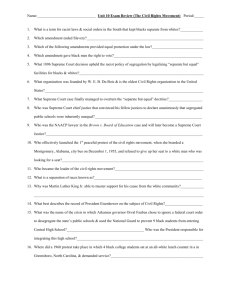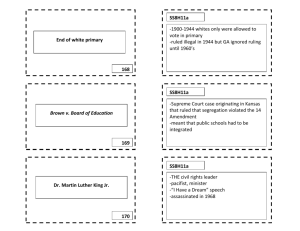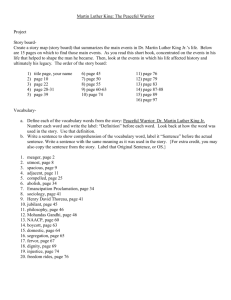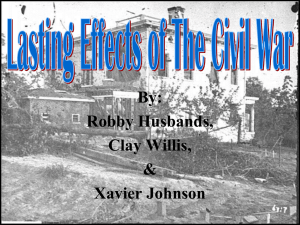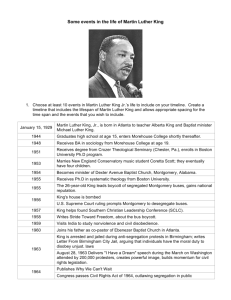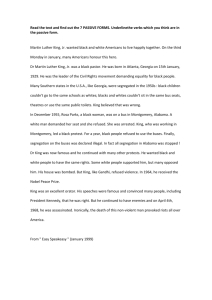Free at last bullet
advertisement
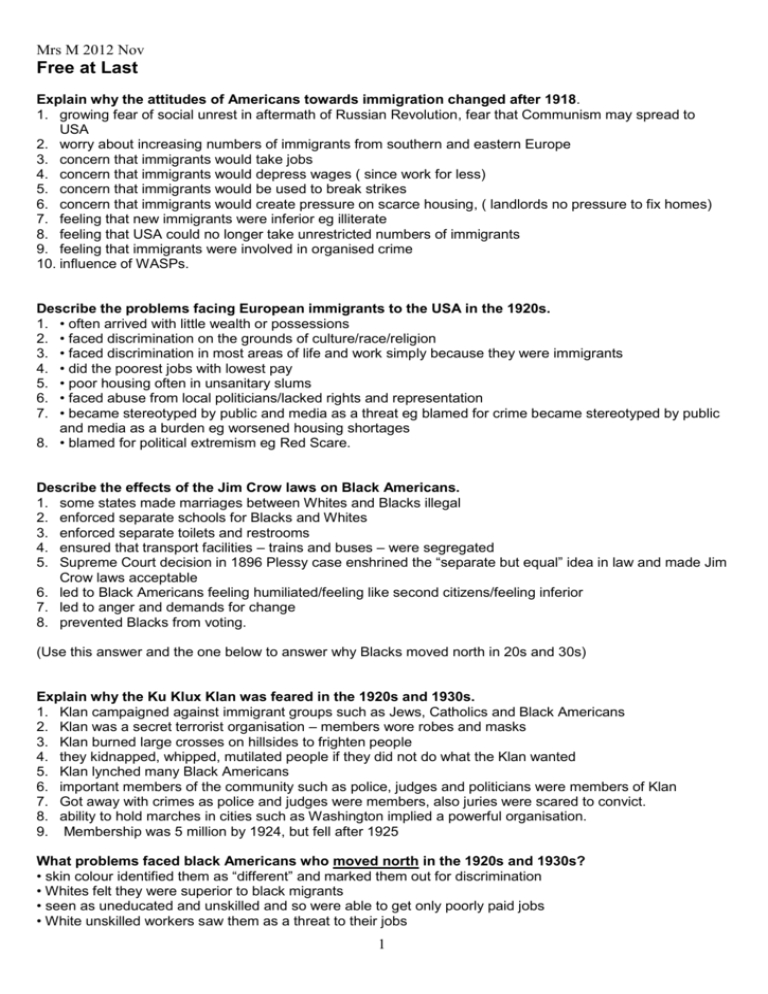
Mrs M 2012 Nov Free at Last Explain why the attitudes of Americans towards immigration changed after 1918. 1. growing fear of social unrest in aftermath of Russian Revolution, fear that Communism may spread to USA 2. worry about increasing numbers of immigrants from southern and eastern Europe 3. concern that immigrants would take jobs 4. concern that immigrants would depress wages ( since work for less) 5. concern that immigrants would be used to break strikes 6. concern that immigrants would create pressure on scarce housing, ( landlords no pressure to fix homes) 7. feeling that new immigrants were inferior eg illiterate 8. feeling that USA could no longer take unrestricted numbers of immigrants 9. feeling that immigrants were involved in organised crime 10. influence of WASPs. Describe the problems facing European immigrants to the USA in the 1920s. 1. • often arrived with little wealth or possessions 2. • faced discrimination on the grounds of culture/race/religion 3. • faced discrimination in most areas of life and work simply because they were immigrants 4. • did the poorest jobs with lowest pay 5. • poor housing often in unsanitary slums 6. • faced abuse from local politicians/lacked rights and representation 7. • became stereotyped by public and media as a threat eg blamed for crime became stereotyped by public and media as a burden eg worsened housing shortages 8. • blamed for political extremism eg Red Scare. Describe the effects of the Jim Crow laws on Black Americans. 1. some states made marriages between Whites and Blacks illegal 2. enforced separate schools for Blacks and Whites 3. enforced separate toilets and restrooms 4. ensured that transport facilities – trains and buses – were segregated 5. Supreme Court decision in 1896 Plessy case enshrined the “separate but equal” idea in law and made Jim Crow laws acceptable 6. led to Black Americans feeling humiliated/feeling like second citizens/feeling inferior 7. led to anger and demands for change 8. prevented Blacks from voting. (Use this answer and the one below to answer why Blacks moved north in 20s and 30s) Explain why the Ku Klux Klan was feared in the 1920s and 1930s. 1. Klan campaigned against immigrant groups such as Jews, Catholics and Black Americans 2. Klan was a secret terrorist organisation – members wore robes and masks 3. Klan burned large crosses on hillsides to frighten people 4. they kidnapped, whipped, mutilated people if they did not do what the Klan wanted 5. Klan lynched many Black Americans 6. important members of the community such as police, judges and politicians were members of Klan 7. Got away with crimes as police and judges were members, also juries were scared to convict. 8. ability to hold marches in cities such as Washington implied a powerful organisation. 9. Membership was 5 million by 1924, but fell after 1925 What problems faced black Americans who moved north in the 1920s and 1930s? • skin colour identified them as “different” and marked them out for discrimination • Whites felt they were superior to black migrants • seen as uneducated and unskilled and so were able to get only poorly paid jobs • White unskilled workers saw them as a threat to their jobs 1 Mrs M 2012 Nov • there was competition for jobs with immigrants to USA • there were riots between Blacks and Whites in north • they were separated into ghetto communities in northern cities • housing conditions were very poor. Explain why the demand for civil rights continued to grow after 1945. 1. impact of the Second World War eg USA fighting against a violent racist regime abroad while violent racism flourished in the southern states. Double V campaign - victory in europe and victory in civil rights. 2. experience of black soldiers from the south who witnessed integration abroad 3. actions of early campaigners eg Phillip Randolph, Core (1942) NAACP 4. the existence of Jim Crow laws in the southern states, continuance of lynching 5. effects of segregation – eg schools, transport, restaurants 6. concern at other inequalities faced by Black Americans eg low wages, poor housing 7. Other non whites gaining equality e.g. India, inspired. Describe the events of the Montgomery bus boycott. 1. • Rosa Parks refused to move seats on the bus 2. • Rosa Parks was arrested and fined 3. • black population refused to use city buses 4. • people walked to work or organised car pools 5. • established Martin Luther King as a civil rights leader 6. • bus company faced bankruptcy 7. • after a year courts decided segregation on buses was unconstitutional. Why did black Americans feel that progress towards civil rights had been made between 1945 and 1959? 1. 2. 3. 4. 5. 6. 7. 8. • NAACP were the moving force behind Supreme Court decisions • the Supreme Court declared segregated schools unconstitutional • black pressure forced Eisenhower to propose a Civil Rights Act • Civil Rights Movement was gaining heroes such as Rosa Parks • mass action such as Montgomery Bus Boycott was successful • protest at Little Rock saw black students admitted to a white school • details of Brown v Topeka Board of Education decision • rise of new civil rights’ leaders such as Martin Luther King and SCLC. Explain why a civil rights movement grew in the USA in the 1950s and 1960s. 1. 2. 3. 4. 5. 6. 7. 8. 9. existence of Jim Crow laws in southern states existence of segregation – examples such as schools, waiting rooms concern at inequalities of black Americans eg extreme poverty, poor housing refusal of southern states to desegregate eg Brown v Topeka success of the bus boycott in Montgomery leadership of Martin Luther King eg “I have a dream” speech the belief that a non-violent campaign would succeed reaction of groups like the Ku Klux Klan growing support from Whites eg students and groups like CORE. Why was the march on Washington important for the Civil Rights Movement? • large numbers involved:. Attended by 250,000 people, including 50,000 white people at Lincoln Memorial, Washington D.C. • about 20 per cent were Whites showing support • march was peaceful and orderly. 2 Mrs M 2012 Nov • millions watched march on TV across USA • march covered by TV crews from across the world • Martin Luther King delivered his “I have a dream” speech. Why was the protest in Birmingham in 1963 an important event in the civil rights’ campaign in the USA? 1. Birmingham was the most racist city in the USA 2. civil rights protestors would risk their lives by entering Birmingham 3. a successful demonstration in Birmingham could spark off changes across the South 4. over nine hundred children were arrested on the first day 5. police used massive violence against protestors – use of clubs, dogs, fire hoses 6. the march gained huge media coverage and shocked American society 7. MLK worked with businessmen to agree desegregation in Birmingham. 8. President Kennedy announced a new civil rights law within weeks 9. Connor, the police chief, was a racist. 10. Showed peaceful protest successful and Blacks had economic power, could achieve equal rights by using this economic power. Explain the importance of Martin Luther King to the Civil Rights’ Movement. 1. his ideas of non-violence very important, eg peaceful demonstrations, bus boycotts, sit-ins 2. speeches very influential, especially “I have a dream” speech 3. March on Washington very significant – Martin Luther King key figure in this 4. one of the most important Civil Rights’ leaders – gave people a dream to live for 5. martyr who died for his beliefs 6. brought race relations to forefront of news 7. Martin Luther King became a worldwide figure – racism being fought everywhere 8. Acceptable figure to work with white politicians e.g. kennedy. 9. Helped gain the Voting Rights Act 1965. Why did Martin Luther King plan a Civil Rights protest in Selma, Alabama in 1965? • King wanted to put pressure on President Johnson to support new Civil Rights legislation • Sheriff Clark of Selma was a crude, violent racist. King thought he could stir up feeling against Clark in the same way as he had against Bull Connor • there was a march as part of the protest to Governor Wallace about police brutality and racism. • King wanted to win support for a new voting rights act • Black Americans were being prevented from registering to vote in Selma • very few Black Americans had succeeded in registering to vote in Selma • local Civil Rights campaigners had already begun organising protests in Selma • protests in Selma had been met with extreme violence from police/TV coverage. Black Power 1950s increased membership of Nation of Islam, led by Elijah Muhammed. They wanted a race war, a separate state for black people and replaced ‘Christian slave surnames’ with the letter X. Grew into the Black Power movement. Black Panthers was one of the most militant groups, led by Malcolm X. Popular in northern states where no real progress had been made. Caused riots in 1960s in Harlem and New York, and Watts in LA. Civil Rights Legislation President Eisenhower passed Civil Rights Acts of 1957 and 1960 – made discrimination illegal and gave the right to vote.(But ignored) 3 Mrs M 2012 Nov Kennedy’s programme was put into place by Johnson. Led to the Civil Rights Act 1964 – banned racial discrimination in employment, black pupils were given equal rights to enter all public places and the Equal Employment Opportunities Commission was set up to investigate complaints of discrimination. 1965 – Voting Rights Act. 1967 – state laws banning interracial marriage were declared illegal. 1968 – Fair Housing Act made discrimination illegal in the property market. In what ways did the Civil Rights Movement improve the lives of black Americans? 1. campaign over Brown v Board of Education, Topeka led the Supreme Court to state that ‘Separate but Equal’ in education was unconstitutional 2. the Montgomery Bus Boycott led to the end of segregation on city buses 3. the movement helped bring about the Civil Rights Act 1957 which gave some legal support to black Americans seeking to register to vote 4. sit-ins led to the end of segregation at lunch counters 5. freedom rides contributed to the end of segregation on inter-state buses 6. the movement helped bring about the Civil Rights Act 1964 banned segregation in public areas/education/employment 7. Voting Rights Act 1965 banned obstacles to voter registration 8. Civil Rights Act 1968 provided protection for civil rights workers helping black people in the South. Why did Malcolm X oppose non-violent protest? 1. 2. 3. 4. 5. 6. 7. 8. Malcolm‟s mistreatment in his youth gave him different attitudes towards Whites from Martin Luther King he became influenced by the ideas of Elijah Mohammed who preached hatred of White people he believed that support of non-violence was a sign that Black people were still living in mental slavery he believed violent language and threats would frighten the authorities into action. Malcolm X claimed that even Whites who appeared friendly were „wolves in sheep‟s clothing‟ he believed that non-violence deprived Black people of their right to self-defence he claimed that peaceful protest gained little for most Black people he didn‟t think non-violent campaigns tackled the problems for Blacks in northern cities. Why did the Black Panthers gain support from many Black Americans? • Black Panthers argued it was time to defend Black Americans from white aggression • Blacks distrusted the police and had no faith in them • Black Panthers organised self-help programmes • Black Panthers had a ten point programme demanding freedom and release of black prisoners. • Black Panthers condoned use of violence • had programmes to give free breakfasts to children and free health clinics • Black Panthers attracted support from sportsmen eg Olympic salute. Explain why black people rioted in many American cities in the 1960s. • poverty – 40% of black Americans still lived in poverty • nothing had been done about slum housing with overcrowding and high rents • blacks were in low paid jobs or had no jobs • they had poor quality schools and facilities • blacks had poor health and little access to health care • ghettos were places of crime, gangs and drugs • feeling that Civil Rights Act had not solved problems in northern cities • assassination of Martin Luther King • riots broke out during summer heatwaves • disillusionment with the draft/Vietnam War • influence of Radical leaders encouraged action • heavy-handed policing/brutality caused anger among blacks. Short term factors e.g. Watts Riot - by kid arrested after drink driving. 4

